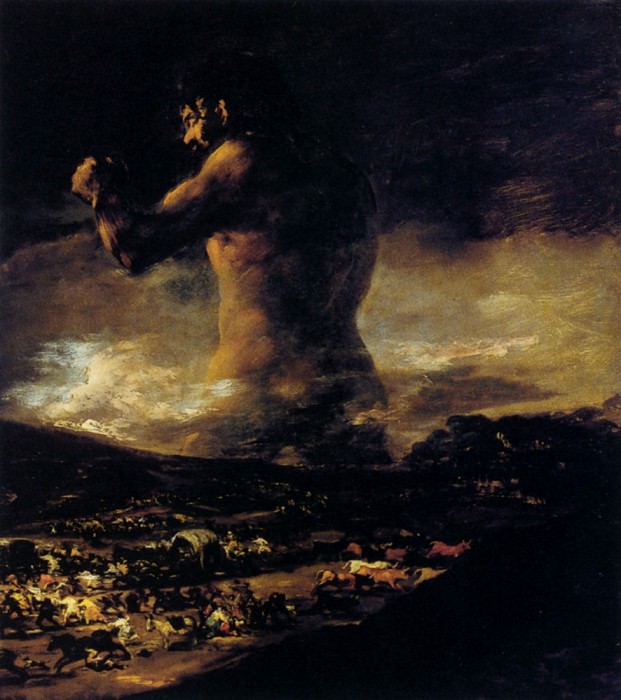The Colossus Francisco Jose De Goya y Lucientes (1746-1828)
Francisco Jose De Goya y Lucientes – The Colossus
Edit attribution
Download full size: 886×1000 px (0,3 Mb)
Painter: Francisco Jose De Goya y Lucientes
The painting "Colossus" by Francisco de Goya was painted between 1810 and 1825. The talented artist has always been able to convey through his paintings all the feelings that overwhelm him, so that even centuries later, admirers of his art are seized by passion, irrepressible joy, moments of admiration and tenderness, but most often, viewers of paintings are bound by panic-stricken terror. Yes, Goya is a master at conveying terrifying moments that not every fantasy is capable of. The painting Colossus also evokes horror and panic at the inevitability of enormous power, unexplored force, and human helplessness before the mighty Colossus. A huge creature, aggressively clenched fists, an unkind look from under shaggy eyebrows - what does it carry - is it protection from trouble, or will it itself become the cause of agonizing terror? The foreground depicts people and animals trying to escape, to flee from the mighty and unkind force, but the viewer understands that there is no way to escape.
Description of Francisco de Goya’s painting "Colossus"
The painting "Colossus" by Francisco de Goya was painted between 1810 and 1825.
The talented artist has always been able to convey through his paintings all the feelings that overwhelm him, so that even centuries later, admirers of his art are seized by passion, irrepressible joy, moments of admiration and tenderness, but most often, viewers of paintings are bound by panic-stricken terror. Yes, Goya is a master at conveying terrifying moments that not every fantasy is capable of.
The painting Colossus also evokes horror and panic at the inevitability of enormous power, unexplored force, and human helplessness before the mighty Colossus.
A huge creature, aggressively clenched fists, an unkind look from under shaggy eyebrows - what does it carry - is it protection from trouble, or will it itself become the cause of agonizing terror?
The foreground depicts people and animals trying to escape, to flee from the mighty and unkind force, but the viewer understands that there is no way to escape. It becomes unbearable.
The same feelings arose in all the people and in Francisco Goya himself after the war with France began in 1808. The French burned cities, bringing death, grief, misery and unceasing terror.
After the burning of the painter’s hometown of Zaragoza, Goya experienced an unprecedented shock. It was the horrors of war, ruthlessness, inhumanity that the artist conveyed in the image of a terrible, huge figure of the Colossus.
True, some art historians believe that the image of Colossus embodied the power of the people, which rose against the French troops. The clenched fists, the tense body - everything speaks of a readiness to fight and battle. The giant’s gaze is turned to the side, it is claimed that he is looking at Napoleon with such hatred.
Whose version is the truth is unknown, but it is clear that it was the sizzling fear of war that the artist was trying to convey.
Кому понравилось
Пожалуйста, подождите
На эту операцию может потребоваться несколько секунд.
Информация появится в новом окне,
если открытие новых окон не запрещено в настройках вашего браузера.
You need to login
Для работы с коллекциями – пожалуйста, войдите в аккаунт (open in new window).




















You cannot comment Why?